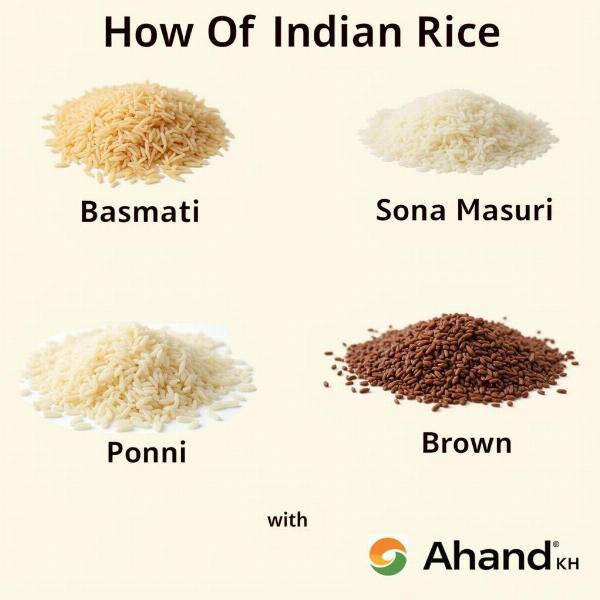Chawal meaning in Hindi is simply “rice,” a staple food across India and a cornerstone of its diverse culinary landscape. But understanding the true meaning of “chawal” goes beyond a simple translation. It encompasses cultural significance, agricultural practices, and the very fabric of Indian life. From everyday meals to religious ceremonies, rice plays a vital role. This article explores the multifaceted meaning of “chawal” within the Indian context.
Different Types of Chawal in India
India boasts an incredible variety of rice, each with its own unique characteristics and culinary applications. From the fragrant Basmati rice to the nutty-flavored brown rice, the options are endless. Some popular varieties include:
- Basmati: Known for its long grains and aromatic fragrance, Basmati rice is often used for special occasions and festive dishes like biryani.
- Sona Masuri: This medium-grain rice is prized for its light and fluffy texture, making it perfect for everyday meals.
- Ponni: A popular variety in South India, Ponni rice is known for its soft texture and is ideal for idli and dosa batter.
- Brown Rice: Increasingly popular for its health benefits, brown rice retains its bran and germ layers, providing more fiber and nutrients.
 Different Types of Indian Rice
Different Types of Indian Rice
Chawal in Indian Cuisine: Beyond the Basics
Rice is more than just a carbohydrate; it’s a canvas for culinary creativity. From simple dal-chawal (lentil and rice) to elaborate pulaos and biryanis, chawal forms the base of countless Indian dishes. Each region has its unique rice-based specialties, reflecting the diversity of Indian cuisine. Consider these examples:
- Biryani: A mixed rice dish with meat, vegetables, and aromatic spices, biryani is a culinary masterpiece enjoyed throughout India.
- Pulao: A flavorful rice dish often cooked with vegetables, herbs, and sometimes meat, pulao is a simpler yet satisfying dish.
- Khichdi: A comforting porridge-like dish made with rice and lentils, khichdi is often considered a light and easily digestible meal.
- Idli and Dosa: These popular South Indian breakfast items are made from fermented rice batter, showcasing the versatility of rice in different forms.
Cultural Significance of Chawal
Chawal holds deep cultural significance in India. It’s not merely a food source; it’s intertwined with traditions, rituals, and everyday life. For example, in many Indian weddings, rice is thrown over the newlywed couple as a symbol of prosperity and fertility. During festivals, rice is used in various ceremonies and offerings.
The Agricultural Importance of Chawal
Rice cultivation is a crucial part of the Indian economy, employing millions of farmers across the country. Understanding the agricultural practices and challenges related to rice production is essential for appreciating the significance of “chawal.” From planting and harvesting to processing and distribution, the entire process impacts livelihoods and food security. “Understanding the cultivation of ‘chawal’ is as important as understanding its culinary applications,” says Dr. Anika Sharma, an agricultural economist specializing in Indian crop production. “It’s the backbone of our agricultural sector.”
Conclusion: More Than Just a Grain
“Chawal” in Hindi signifies more than just rice; it represents a cornerstone of Indian culture, cuisine, and agriculture. From the diverse varieties and culinary applications to its cultural and economic importance, rice plays a vital role in the lives of millions of Indians. Understanding the full meaning of “chawal” allows us to appreciate the rich tapestry of Indian life.
FAQ
- What is the nutritional value of chawal? Rice is a good source of carbohydrates, providing energy for the body. Brown rice is particularly nutritious, as it contains more fiber and vitamins than white rice.
- What are some popular ways to cook chawal? Rice can be boiled, steamed, or cooked in a pressure cooker. It can also be used to make various dishes like biryani, pulao, and khichdi.
- What is the difference between Basmati and other types of rice? Basmati rice is known for its long grains and distinct aroma. Other types of rice may have different textures and flavors.
- Is brown rice healthier than white rice? Yes, brown rice is generally considered healthier than white rice because it retains its bran and germ layers, which are rich in fiber, vitamins, and minerals.
- What is the significance of chawal in Indian culture? Rice is an essential part of Indian cuisine and culture, used in various ceremonies, festivals, and everyday meals.
- How is chawal cultivated in India? Rice is cultivated in flooded paddy fields, requiring specific agricultural practices and water management techniques.
- What are some regional variations of rice dishes in India? Different regions of India have their unique rice-based specialties, reflecting the diversity of Indian cuisine.
Meaning-Hindi.in is your trusted partner for professional Hindi translation services. We specialize in various domains, including business, legal, technical, website localization, educational, and specialized translations. Our team of expert linguists ensures accurate and culturally sensitive translations, tailored to your specific needs. Contact us today for a free quote and experience the Meaning-Hindi.in difference. Email: [email protected], Phone: +91 11-4502-7584.